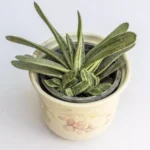As with other cool-season veggies, timing is everything, and finding the right growing period between too-warm and too-frosty temperatures is the key.
How to Plant Broccoli
Whether growing broccoli for a spring harvest or late fall, seedlings need warmth to get started, while the harvest requires cool weather and vernalization. Though it’s considered a cool-season crop, there are broccoli-loving plant breeders who constantly try to come up with a heat-tolerant hybrid.
Growing From Seed
For a spring harvest, start seeds indoors at room temperature in late winter roughly 3-4 weeks before the last frost. You won’t need a heat mat, but a grow light will foster steady, strong growth. The light from a window is unlikely to be strong enough. Using a seedling cell tray with drainage holes and a tray without underneath it, plant two seeds to a cell ¼ inches deep and keep warm and moist—watering in the bottom tray until seedlings begin to grow. Then gradually reduce the temperature and finally harden off (acclimate to outdoor temperatures) before planting in rows.

For a fall harvest, direct-plant outdoors in summer. Broccoli seeds should be planted about ½ inches deep in the soil and 5 or 6 inches apart to be thinned later to about 18 inches apart. If your zone is too hot in summer, plant indoors as above, estimate the date to allow for harvesting before a freeze sets in. In mild climates, it’s possible to plant late in fall and grow through the winter, but be ready to protect the broccoli from hard frost if needed.
Transplanting
Transplant broccoli starts when they are 4-6 weeks old and have several true leaves. Use a trowel to dig holes that will allow the soil plug the plant has been growing in to be level with the soil. Fill and pat soil into place, then water in. You can use a diluted liquid seed starting formula or fertilizer when you water the first time.
Broccoli Care
Rich soil, steady watering, and monitoring for pests are needed for broccoli success.
Light
Broccoli needs a full day of sunlight, 6-8 hours. Keep in mind, broccoli grows in seasons with shorter days and weaker light.
Soil and Nutrients
Broccoli thrives in soil with plenty of organic matter and nitrogen. Planting after a leguminous cover-crop can be beneficial, but a new method has been developed by the USDA Agricultural Research Service and Virginia Polytechnic Institute that employs planting soy to outgrow weeds, then chopping it or rolling over it to leave a thick, weed-blocking thatch that retains moisture and adds nutrients, prevents erosion and reduces chemical use.
Broccoli also needs phosphate and potassium, and you can test your soil to see if it needs amendments to balance all these nutrients.
Soil that is too sandy or has too much clay may benefit from the addition of humic substances, according to a study carried out by three universities.
They found that adding this kind of soil amendment via fertigation increased water and nutrient retention in sandy soil, which led to an increase in the nutritional value of broccoli heads.
Water
Broccoli thrives best on regular irrigation and may respond to water stress by forming the head before the plant is ready. Make sure the plant is getting adequate water, especially when larger leaves have filled out and just as it begins to form the head
Since broccoli requires steady moisture and detests competing weeds, a thick mulch can provide a solution to both requirements.
Common Pests and Diseases
Flea-beetles, wireworms, cabbage loopers, and cutworms may attack broccoli, depending on location, but aphids are a notorious and widespread broccoli-ruining pest. The tiny, seed-sized sap-suckers really make the most of the nooks and crannies to steal moisture from the plant and create a nasty infestation. One solution is to blast them off the plant with a stream of water from a garden hose and repeat several days in a row. Another is to plant alyssum between rows or plants to attract predators that eat aphids. If all else fails, some organic, soap-based spray may help.
To avoid diseases like black rot or powdery mildew, rotate brassica crops, leaving a long time between turns. Growers can protect broccoli plants from other pests and sun or wind damage by using a floating row cover.
Broccoli Varieties
Aside from the well-known, rounded-head broccoli types such as Calabrese that look like kids’ drawings of trees, there are surprising varietals that are catching on.
Rapini: Also called broccoli raab, this is a closer relative to the turnip. It matures faster and so has fewer potential problems, and it can be harvested a bit at a time through the cool season. It also has a distinct, slightly bitter flavor that works well in Italian and Asian dishes.
Sprouting broccoli and Chinese broccoli, or Gai lan: This variety is valued for their tender stems and leaves, like asparagus, rather than a big head. Ready to harvest in 60-70 days, these may be a little more flexible about temperature and last well into cold weather. Purple versions contain anthocyanins, which are antioxidants attached to the purple pigment. Broccolini is a hybrid of broccoli and Chinese broccoli.
Romanesco: Between broccoli and cauliflower on the brassica family tree, romanesco looks like something from outer space, with its spiral patterns and neon green color. Its slightly nutty, mild taste and nubby consistency let it beautify a variety of recipes.
How to Harvest Broccoli
Using a sharp knife, cut the stalk of the broccoli head where it meets the main stem and then chill as soon as possible. Later, smaller florets will form on the other branches along the sides and can be picked until the plant goes to seed.
Broccoli should be chilled and not allowed to dry out, but it needs a bit of air circulation, so the conventional wisdom suggests loosely wrapping it in moist paper towels. Broccoli is best eaten fresh, but it can also be blanched and frozen.


